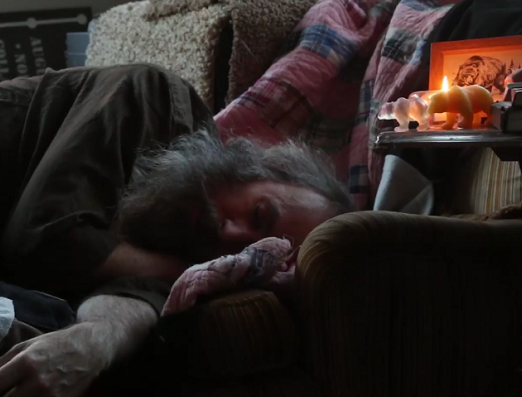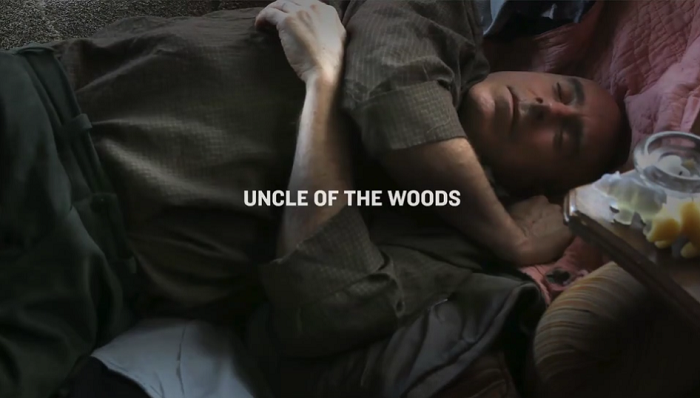
(Image still from Deke Weaver’s Winter BEAR #6 video)
There’s no question that the weather here in central Illinois has been getting warmer faster than usual. Whether you believe in Punxsutawney Phil or the “alternative fact” of global climate change, it seems fitting that this weekend will bring highs in the 60s while The Unreliable Bestiary brings its BEAR out of hibernation. The Station Theatre will be home to an awakening beast for the next two weekends, which will sadly bring this three-part interactive, multimedia art installation to a close.
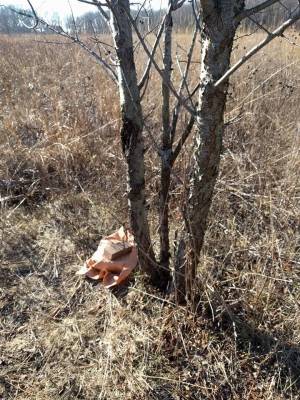 Deke Weaver and his accomplices have built an engrossing story of a near-future world – 2020 with risen sea levels and little to no electricity – where rangers in the Allerton-Meadowbrook-Kickapoo parks are trying to attract apex predators back to the area and re-balance the biome. For those of us who have been immersed in that world since fall, it will be the culmination of six months’ worth of randomly remembering snippets of story, phantom face-mask itching, and traipsing through muddy parks on a mini-geocaching adventure (btw – videos 5 and 6 are up). But if you missed the first two parts, or have no idea what an Unreliable Bestiary could possibly be, an evening spent at the Station with Deke Weaver’s den of incredibly talented artists promises an experience that will be worthwhile.
Deke Weaver and his accomplices have built an engrossing story of a near-future world – 2020 with risen sea levels and little to no electricity – where rangers in the Allerton-Meadowbrook-Kickapoo parks are trying to attract apex predators back to the area and re-balance the biome. For those of us who have been immersed in that world since fall, it will be the culmination of six months’ worth of randomly remembering snippets of story, phantom face-mask itching, and traipsing through muddy parks on a mini-geocaching adventure (btw – videos 5 and 6 are up). But if you missed the first two parts, or have no idea what an Unreliable Bestiary could possibly be, an evening spent at the Station with Deke Weaver’s den of incredibly talented artists promises an experience that will be worthwhile.
To that end, when getting together the interview questions for BEAR:Spring, Arts writer Sarah Keim offered up half of the questions, because she did not experience the Fall or Winter installments. The other half are written by me, because I have been all-in since I walked away from Meadowbrook last September. Deke Weaver and Jennifer Allen were kind enough to answer questions from both the uninitiated and the slightly-obsessed.
Sarah Keim [SP]: I like the idea of tying the myth of Persephone to bears in their winter dens. It seems fitting with the BEAR project as a piece tied to the seasons and how nature effects our lives and wildlife differently in summer versus winter. Then I immediately thought about how female bears can give birth towards the end of hibernation and how they use the last of their fat reserves to give the cubs a better start in the spring. So, will there be bear cubs in the spring portion of BEAR?
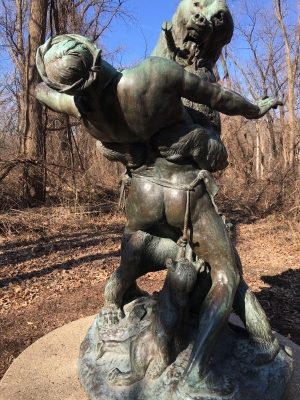 Weaver: Actually, the whole idea of Persephone probably started from stories about bears. Bear stories/myths/rituals are some of the oldest on the planet, and are incredibly similar throughout cultures in the northern hemisphere. The setting for this BEAR Spring Chapter is based on a ritual from the base of the Pyrenees. A village would choose a young man to be The Bear and a young woman to be the Earth Goddess/Persephone. The Bear would terrorize the town for a day or so. Finally The Bear would be lead into a banquet hall with a huge table covered with cake and wine, surrounded by the townspeople. The Bear would meet the Earth Goddess, they’d make love. And this made the world go round, this made the crops grow. This ritual sent winter on its way and ushered in the spring.
Weaver: Actually, the whole idea of Persephone probably started from stories about bears. Bear stories/myths/rituals are some of the oldest on the planet, and are incredibly similar throughout cultures in the northern hemisphere. The setting for this BEAR Spring Chapter is based on a ritual from the base of the Pyrenees. A village would choose a young man to be The Bear and a young woman to be the Earth Goddess/Persephone. The Bear would terrorize the town for a day or so. Finally The Bear would be lead into a banquet hall with a huge table covered with cake and wine, surrounded by the townspeople. The Bear would meet the Earth Goddess, they’d make love. And this made the world go round, this made the crops grow. This ritual sent winter on its way and ushered in the spring.
The timeline of bear birth is pretty amazing. The bears mate in the summer, but the female’s body doesn’t implant the fertilized egg into the uterine wall until she’s in hibernation. A female polar bear came out of the den in the spring weighing 200 pounds. When she went into the den in the late fall – knowing that she was going to have cubs – she weighed 1000 pounds. She’d quintupled her weight. So … yes, there will be cubs in our BEAR spring chapter. But part of what we’re playing with in these spring stories is the fluidity of animal/human attributes … or taking a bear’s physiology and putting it on a human being – like a human woman tripling her weight in 4 months, going from 135 pounds to 405 pounds all so she could sleep for six months without eating, drinking, urinating, or defecating.
Keim [SP]: How long does it take to develop these projects and then see them through the final performance? Each project seems very intense in planning, designing, choreographing, practicing, and executing along with acquiring funding along the way.
Weaver: We did WOLF in September 2013, so it was 3 years until we opened BEAR’s September 2016 Fall Chapter. ELEPHANT was 2010. 2009’s MONKEY was a smaller production without the same kind of research or fundraising. After WOLF in 2013, in addition to researching, fundraising, and writing BEAR, the three years have included me editing the multi-camera shoot of WOLF (filmed by Shatterglass Studios), preparing and touring a solo version of WOLF, and working on the book version of ELEPHANT. As we got closer to what we decided will be the show date, we start gathering the troops and finding time when we can all be together. Some of our collaborators have moved (or never lived here in the first place) so, finding time that works for everyone is sticky. I started meeting with all the good folk at Urbana Park District and Krannert Center in Fall 2015. There’s a lot of reading. There was a lot of going out to see bears (northern Minnesota, Montana, Wyoming). And then there’s following ideas that seem related to the train of thought that the research is building – for instance Camus’ The Stranger plays a significant part in this piece.
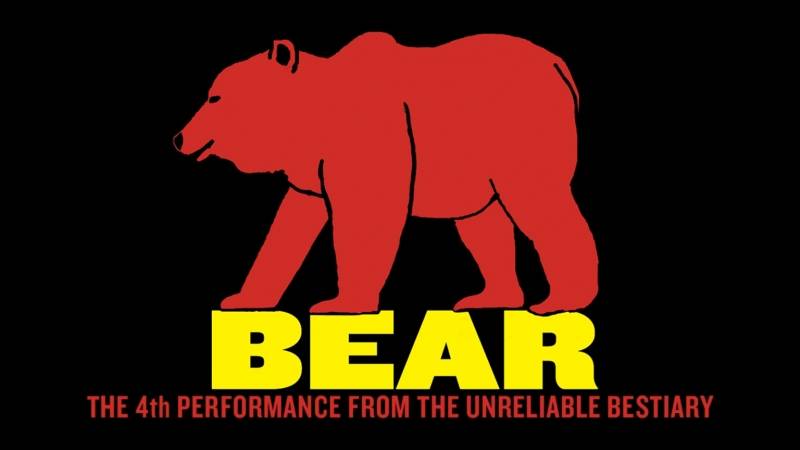
Knaur [SP]: BEAR (Fall/Winter) and WOLF were both very in tune with the nature around us, but Spring BEAR being at the Station immediately makes me think of MONKEY, which sounded much more like a storytelling experience. Am I on the right track, can you give us a glimpse without spoilers? Most importantly: do I need to wear mudshoes to the Station?
Weaver: You will not need to wear mud-shoes in the Station … unless you’re into that. We’re continuing the world we were building in the fall. There is more storytelling but I’m thinking it might feel more like the barn section of WOLF than MONKEY. Some parts might feel hypnotic, related to a narrative structure of traveling into a dream.
Knaur [SP]: Since the Unreliable Bestiary has grown in scope and now embraces scores of artists, what types of artistic expression can we look forward to with Spring? (I hope Jennifer will expound if there will be dancing…)
Weaver: To help with the … well, I guess what our friend and collaborator Andy Warfel described as “that razor line where the absurd meets the sublime” … we worked with Chris Green, a master puppeteer. With my video background, I’m attracted to projections, but with this 2020 BEAR world we’ve built – post-climate, post-oil, post-crash – there isn’t video. There’s barely even any power. But there are still shadows on the walls of the cave. So shadow puppets play a role in this show along with live music – Beth Simpson singing and doing some non-trained cello playing, Charlie Harris and Cody Jensen from Bones Jugs. Jen can talk about the dancing.
Allen: Because this show is in the Station Theater, many aspects of it will feel more like a traditional theater piece. The audience, for the most part, will be seated and watching the production for its entirety. The journey that we take them on will be more of a dreamy, mental journey as compared to the Fall Chapter where we had people walking in the woods at night, holding hands and chanting, crawling through tunnels, etc. This will feel quite different from that. As a choreographer and director, I don’t like to assume there will be dancing in every show. After Deke has written the script, I look to see if there are places where the story truly calls for movement, or characters that move. For the Spring Chapter, there are definitely characters that move! There is a beautiful set designed and being built by Andy Warfel. And there will be live music composed by Chris Peck and played by Cody Jenson, Charley Harris and Beth Simpson. I don’t want to give away too many details, as we do like the audience to feel they’re stepping into the unknown.
Knaur [SP]: Will there be more to hear about the man with the Oak Heart? Because he is definitely on my mind, but that makes him effective without needing to be finished. Just curious.
Weaver: Yes, the man with the oak heart is back.
Knaur [SP]: Was the choice of the Station Theatre intentional for this installation — a way to spread the artistic love around Urbana since you’d already cooperated with Krannert? Or was it just a matter of logistics/availability? If you had your choice of anywhere in town, what would be your ideal venue?
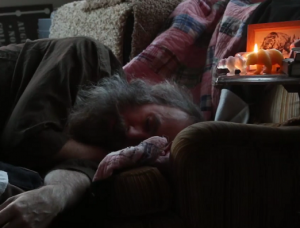 Weaver: We love the Station Theatre. The audiences are warm. It’s a gorgeous space. And everyone who works there is great. Making these shows takes a lot of energy. After finishing BEAR’s Fall Chapter, I had a big crash and I found myself wondering, “Why did I say this was going to be 3 parts?” Knowing it was going to be in the Station made it feel like everything was going to be o.k. So far as “an ideal venue” – I think it’s more about finding a fit for the particular show. The Stock Pavilion felt good for ELEPHANT because of the scale of the place and because elephants are classified as livestock in Thailand. The barn and the woods and the bus for WOLF felt right for the odd mix of Red Riding Hood, Yellowstone, Isle Royale, monocultural farmland, and oozy new-age nature cult we were brewing. So, the Station feels right for some close storytelling about the end of the world, all of us huddled with warmth, wine, and cake around a big old table of scrap.
Weaver: We love the Station Theatre. The audiences are warm. It’s a gorgeous space. And everyone who works there is great. Making these shows takes a lot of energy. After finishing BEAR’s Fall Chapter, I had a big crash and I found myself wondering, “Why did I say this was going to be 3 parts?” Knowing it was going to be in the Station made it feel like everything was going to be o.k. So far as “an ideal venue” – I think it’s more about finding a fit for the particular show. The Stock Pavilion felt good for ELEPHANT because of the scale of the place and because elephants are classified as livestock in Thailand. The barn and the woods and the bus for WOLF felt right for the odd mix of Red Riding Hood, Yellowstone, Isle Royale, monocultural farmland, and oozy new-age nature cult we were brewing. So, the Station feels right for some close storytelling about the end of the world, all of us huddled with warmth, wine, and cake around a big old table of scrap.
—
Performances of The Unreliable Bestiary’s BEAR: Spring Chapter will be staged at the Station Theatre for two weekends beginning this Thursday, February 16th at 8 p.m. Tickets are $15 for Fri/Sat shows and $10 on Wed/Thurs/Sun. BEAR‘s Spring Chapter is not appropriate for children under 14, due to intense imagery.
If you would like to know more about the BEAR production, you can read my review of the Fall chapter, or watch a Fall performance and catch up on the scavenger hunt with at Deke Weaver’s vimeo page.
Images courtesy David Bellmore, Christopher Needham, the Unreliable Bestiary website, and stills from Deke Weaver’s vimeo posts for BEAR:Winter.








